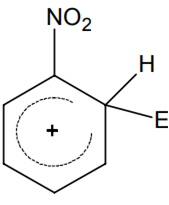 Multiple Choice Questions
Multiple Choice QuestionsThe IUPAC name of neopentane is
2-methylbutane
2, 2-dimethylpropane
2-methylpropane
2-methylpropane
The electrophile, E⊕ attacks the benzene ring to generate the intermediate σ-complex. Of the following, which σ-complex is of lowest energy?




Which one of the following is the correct statement?
Boric acid is a protonic acid
Beryllium exhibits coordination number of six
Chlorides of both beryllium and aluminium have bridged chloride structures in solid phase
Chlorides of both beryllium and aluminium have bridged chloride structures in solid phase
Amount of oxalic acid present in a solution can be determined by its titration with KMnO4 solution in the presence of H2SO4. The titration gives unsatisfactory result when carried out in the presence of HCl, because HCl
gets oxidised by oxalic acid to chlorine
furnishes H+ions in addition to those from oxalic acid
reduces permanganate to Mn2+
reduces permanganate to Mn2+
The correct decreasing order of priority for the functional groups of organic compounds in the IUPAC system of nomenclature is
−COOH, −SO3H, −CONH2, −CHO
−SO3H, −COOH, −CONH2, −CHO
−CHO, −COOH, −SO3H, −CONH2
−CHO, −COOH, −SO3H, −CONH2
CH3Br + Nu- → CH3 -Nu +Br-
The decreasing order of the rate of the above reaction with nucleophiles (Nu–) A to D is
[Nu–=
(A) PhO–
(B) AcO–
(C) HO–
(D) CH3O–
]
D > C > A > B
D > C > B > A
A > B > C > D
A > B > C > D
Due to the presence of an unpaired electron, free radicals are:
Chemically reactive
Chemically inactive
Anions
Anions
The decreasing order of nucleophilicity among the nucleophiles
(a), (b), (c), (d)
(d), (c), (b), (a)
(b), (c), (a), (d)
(b), (c), (a), (d)
